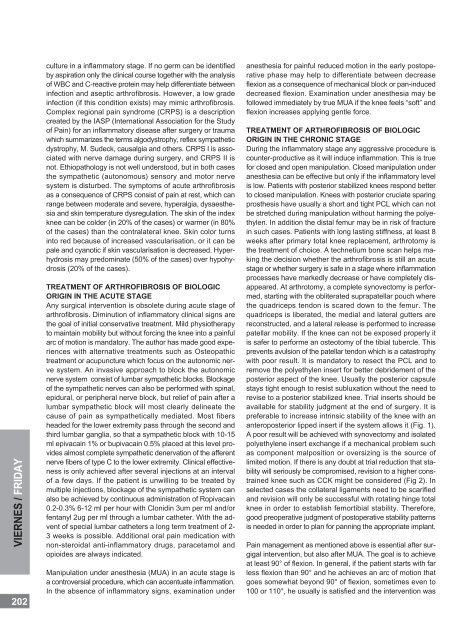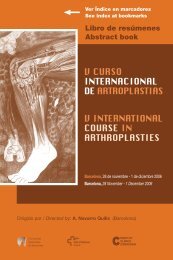Notas / Notes - Active Congress.......
Notas / Notes - Active Congress.......
Notas / Notes - Active Congress.......
Create successful ePaper yourself
Turn your PDF publications into a flip-book with our unique Google optimized e-Paper software.
VIERNES / FRIDAY<br />
202<br />
culture in a inflammatory stage. If no germ can be identified<br />
by aspiration only the clinical course together with the analysis<br />
of WBC and C-reactive protein may help differentiate between<br />
infection and aseptic arthrofibrosis. However, a low grade<br />
infection (if this condition exists) may mimic arthrofibrosis.<br />
Complex regional pain syndrome (CRPS) is a description<br />
created by the IASP (International Association for the Study<br />
of Pain) for an inflammatory disease after surgery or trauma<br />
which summarizes the terms algodystrophy, reflex sympathetic<br />
dystrophy, M. Sudeck, causalgia and others. CRPS I is associated<br />
with nerve damage during surgery, and CRPS II is<br />
not. Ethiopathology is not well understood, but in both cases<br />
the sympathetic (autonomous) sensory and motor nerve<br />
system is disturbed. The symptoms of acute arthrofibrosis<br />
as a consequence of CRPS consist of pain at rest, which can<br />
range between moderate and severe, hyperalgia, dysaesthesia<br />
and skin temperature dysregulation. The skin of the index<br />
knee can be colder (in 20% of the cases) or warmer (in 80%<br />
of the cases) than the contralateral knee. Skin color turns<br />
into red because of increased vascularisation, or it can be<br />
pale and cyanotic if skin vascularisation is decreased. Hyperhydrosis<br />
may predominate (50% of the cases) over hypohydrosis<br />
(20% of the cases).<br />
TREATMENT OF ARTHROFIBROSIS OF BIOLOGIC<br />
ORIGIN IN THE ACUTE STAGE<br />
Any surgical intervention is obsolete during acute stage of<br />
arthrofibrosis. Diminution of inflammatory clinical signs are<br />
the goal of initial conservative treatment. Mild physiotherapy<br />
to maintain mobility but without forcing the knee into a painful<br />
arc of motion is mandatory. The author has made good experiences<br />
with alternative treatments such as Osteopathic<br />
treatment or acupuncture which focus on the autonomic nerve<br />
system. An invasive approach to block the autonomic<br />
nerve system consist of lumbar sympathetic blocks. Blockage<br />
of the sympathetic nerves can also be performed with spinal,<br />
epidural, or peripheral nerve block, but relief of pain after a<br />
lumbar sympathetic block will most clearly delineate the<br />
cause of pain as sympathetically mediated. Most fibers<br />
headed for the lower extremity pass through the second and<br />
third lumbar ganglia, so that a sympathetic block with 10-15<br />
ml epivacain 1% or bupivacain 0.5% placed at this level provides<br />
almost complete sympathetic denervation of the afferent<br />
nerve fibers of type C to the lower extremity. Clinical effectiveness<br />
is only achieved after several injections at an interval<br />
of a few days. If the patient is unwilling to be treated by<br />
multiple injections, blockage of the sympathetic system can<br />
also be achieved by continuous administration of Ropivacain<br />
0.2-0.3% 6-12 ml per hour with Clonidin 3um per ml and/or<br />
fentanyl 2ug per ml through a lumbar catheter. With the advent<br />
of special lumbar catheters a long term treatment of 2-<br />
3 weeks is possible. Additional oral pain medication with<br />
non-steroidal anti-inflammatory drugs, paracetamol and<br />
opioides are always indicated.<br />
Manipulation under anesthesia (MUA) in an acute stage is<br />
a controversial procedure, which can accentuate inflammation.<br />
In the absence of inflammatory signs, examination under<br />
anesthesia for painful reduced motion in the early postoperative<br />
phase may help to differentiate between decrease<br />
flexion as a consequence of mechanical block or pan-induced<br />
decreased flexion. Examination under anesthesia may be<br />
followed immediately by true MUA if the knee feels “soft” and<br />
flexion increases applying gentle force.<br />
TREATMENT OF ARTHROFIBROSIS OF BIOLOGIC<br />
ORIGIN IN THE CHRONIC STAGE<br />
During the inflammatory stage any aggressive procedure is<br />
counter-productive as it will induce inflammation. This is true<br />
for closed and open manipulation. Closed manipulation under<br />
anesthesia can be effective but only if the inflammatory level<br />
is low. Patients with posterior stabilized knees respond better<br />
to closed manipulation. Knees with posterior cruciate sparing<br />
prosthesis have usually a short and tight PCL which can not<br />
be stretched during manipulation without harming the polyethylen.<br />
In addition the distal femur may be in risk of fracture<br />
in such cases. Patients with long lasting stiffness, at least 8<br />
weeks after primary total knee replacement, arthrotomy is<br />
the treatment of choice. A technetium bone scan helps making<br />
the decision whether the arthrofibrosis is still an acute<br />
stage or whether surgery is safe in a stage where inflammation<br />
processes have markedly decrease or have completely disappeared.<br />
At arthrotomy, a complete synovectomy is performed,<br />
starting with the obliterated suprapatellar pouch where<br />
the quadriceps tendon is scared down to the femur. The<br />
quadriceps is liberated, the medial and lateral gutters are<br />
reconstructed, and a lateral release is performed to increase<br />
patellar mobility. If the knee can not be exposed properly it<br />
is safer to performe an osteotomy of the tibial tubercle. This<br />
prevents avulsion of the patellar tendon which is a catastrophy<br />
with poor result. It is mandatory to resect the PCL and to<br />
remove the polyethylen insert for better debridement of the<br />
posterior aspect of the knee. Usually the posterior capsule<br />
stays tight enough to resist subluxation without the need to<br />
revise to a posterior stabilized knee. Trial inserts should be<br />
available for stability judgment at the end of surgery. It is<br />
preferable to increase intrinsic stability of the knee with an<br />
anteroposterior lipped insert if the system allows it (Fig. 1).<br />
A poor result will be achieved with synovectomy and isolated<br />
polyethylene insert exchange if a mechanical problem such<br />
as component malposition or oversizing is the source of<br />
limited motion. If there is any doubt at trial reduction that stability<br />
will seriously be compromised, revision to a higher constrained<br />
knee such as CCK might be considered (Fig 2). In<br />
selected cases the collateral ligaments need to be scarified<br />
and revision will only be successful with rotating hinge total<br />
knee in order to establish femortibial stability. Therefore,<br />
good preoperative judgment of postoperative stability patterns<br />
is needed in order to plan for panning the appropriate implant.<br />
Pain management as mentioned above is essential after surgigal<br />
intervention, but also after MUA. The goal is to achieve<br />
at least 90° of flexion. In general, if the patient starts with far<br />
less flexion than 90° and he achieves an arc of motion that<br />
goes somewhat beyond 90° of flexion, sometimes even to<br />
100 or 110°, he usually is satisfied and the intervention was





